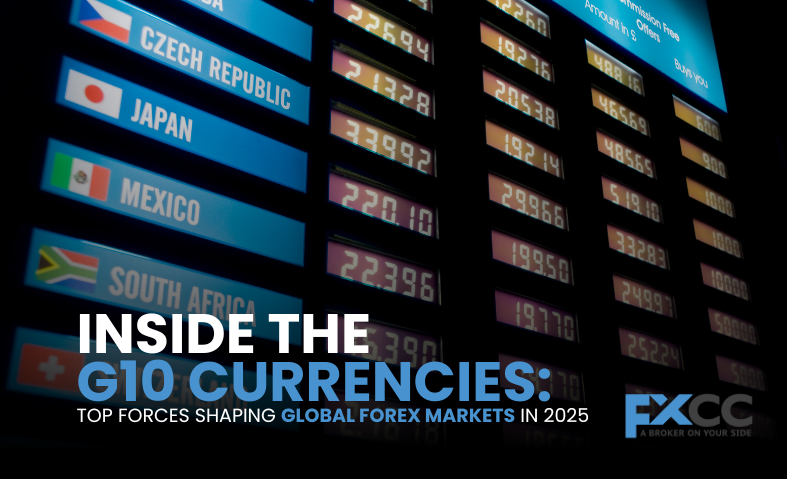The G10 currencies are fundamental pillars in the global foreign exchange landscape. Comprising ten of the world’s most traded and liquid currencies, they embody some of the most stable and influential economies worldwide. Movements in these currencies set the tone for global financial trends and are closely watched by investors, traders, and policymakers alike. Gaining a clear understanding of these currencies is vital for anyone engaged in forex trading or international finance.

Swiss Franc (CHF): A Safe Haven During Turmoil
The Swiss Franc is esteemed globally as a refuge currency, especially during times of economic or political stress. Switzerland’s long-standing policy of neutrality and its robust financial sector contribute to the Franc’s reputation as a symbol of stability and security. When market volatility surges, investors often flock to the CHF, seeking safety. Although Switzerland’s economy is smaller relative to other G10 countries, it is highly developed, technologically advanced, and well-managed. The Swiss National Bank actively intervenes to stabilize the Franc’s value, ensuring its role as a safe haven during global uncertainties.
Canadian Dollar (CAD): Oil’s Influence on a Resource-Linked Currency
Commonly known as the “Loonie,” the Canadian Dollar is heavily influenced by the strength of Canada’s natural resource industries, with oil playing a central role. As a top global oil exporter, Canada often sees its currency rise in value when oil markets experience price increases. The close connection to commodities makes the CAD unique among G10 currencies. Additionally, the Bank of Canada’s monetary policy decisions, especially regarding interest rates, play a significant role in shaping its value. Due to Canada’s close economic ties with the United States, changes in the American economy often have a direct effect on the Canadian Dollar’s movement. The currency is known for its liquidity and resilience in the forex market.
Australian Dollar (AUD): A Barometer of Global Commodity Demand
The Australian Dollar reflects the health of global demand for commodities, primarily minerals and natural resources. As a classic commodity currency, the AUD tends to move in tandem with the global economic cycle. When major importers like China increase their resource consumption, the AUD often appreciates. Conversely, economic slowdowns can lead to depreciation. The Reserve Bank of Australia influences the currency through interest rate policies and economic outlook statements. Traders monitor the AUD closely, as its fluctuations can provide insights into broader global economic trends.
New Zealand Dollar (NZD): A Niche but Crucial Player
Despite its smaller size, New Zealand’s currency—the NZD—commands significant attention within the forex arena. The nation’s economy relies heavily on agriculture, tourism, and exports of natural products. Movements in these sectors often translate into shifts in the NZD’s value. Like Australia, New Zealand maintains strong economic ties with Asia, making the NZD sensitive to regional developments. The Reserve Bank of New Zealand manages the currency’s stability through prudent monetary policy and interest rate adjustments. While less actively traded than the USD or Euro, the NZD remains a vital currency for traders focusing on the Asia-Pacific region.
Swedish Krona (SEK): A Stable Force in Europe
Sweden’s decision to retain its own currency, rather than adopting the Euro, places the Krona as an important European forex component. The SEK reflects Sweden’s innovative and well-regulated economy, with the Riksbank actively managing its value through interest rate adjustments and inflation control. Although not as heavily traded as some other G10 currencies, the Krona is vital within European markets. It is recognized for its stability and consistent performance, mirroring Sweden’s economic resilience and prudent governance.
Norwegian Krone (NOK): Oil Prices as a Key Driver
Norway’s substantial oil reserves strongly influence the NOK’s performance. The Norwegian Krone shows a similar pattern, frequently gaining value when oil prices experience upward trends. Norway’s government manages its oil revenues carefully, using them to support fiscal stability and economic growth. Norges Bank, the central bank, influences the currency through interest rate policies and inflation management. Given its dependence on oil exports, the NOK can experience higher volatility compared to other G10 currencies, but it remains an important player in global trade and investment markets.
The Role of G10 Currencies in Forex Trading
The dominance of G10 currencies in daily forex trading stems from their liquidity, stability, and the strength of their economies. These currencies are traded extensively in pairs, with their movements driven by macroeconomic indicators, central bank policies, geopolitical developments, and global economic data. Traders favor them because of their tight bid-ask spreads and relatively predictable trends. Mastery of G10 currencies is essential for traders seeking to navigate the forex market effectively, as they provide critical insights into global economic health and market sentiment.
Central Banks and Their Market Influence
The monetary authorities of G10 nations wield considerable influence over their respective currencies. Central banks’ decisions—such as altering interest rates, setting inflation targets, or signaling policy shifts—can cause immediate and significant currency fluctuations. Market participants vigilantly track announcements from the US Federal Reserve, the European Central Bank, the Bank of Japan, and other G10 central banks, as their policies impact not only local currencies but also global markets. Understanding how these institutions operate and react to economic data is a crucial aspect of forex trading.

Conclusion: The Significance of G10 Currencies
The G10 currencies are more than just symbols of economic strength; they are vital components of the global financial infrastructure. Representing some of the world’s most stable and interconnected economies, these currencies influence international trade, investment, and economic stability. Whether you are an investor, trader, or simply interested in global markets, a thorough understanding of these currencies provides valuable insights into the world’s economic pulse. Their movements narrate stories of international trade, monetary policy, and economic resilience, making the G10 currencies indispensable players in shaping the future of global markets.


